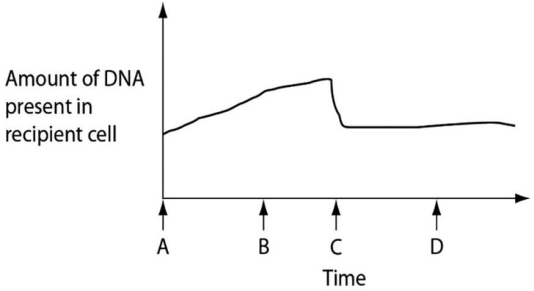Multiple Choice
Figure 24.2 depicts changes to the amount of DNA present in a recipient cell that is engaged in conjugation with an Hfr cell.Hfr cell DNA begins entering the recipient cell at time A.Assume that reciprocal crossing over occurs (in other words,a fragment of the recipient's chromosome is exchanged for a homologous fragment from the Hfr cell's DNA) .Use Figure 24.2 to answer the following question(s) .
 Figure 24.2
Figure 24.2
-Which question arising from the results depicted in Figure 24.2 is most interesting from a genetic perspective and has the greatest potential to increase our knowledge base?
A) If reciprocal crossing over could occur even if the piece of donated Hfr DNA is identical to the homologous portion of the recipient's chromosome,what prevents this from occurring?
B) What forces are generally responsible for disrupting the sex pilus?
C) How is it that a recipient cell does not necessarily become an Hfr cell as the result of conjugation with an Hfr cell?
D) What makes a cell an Hfr cell?
Correct Answer:

Verified
Correct Answer:
Verified
Q27: Which of the following processes is least
Q28: The table depicts characteristics of five prokaryotic
Q29: Which of the following statements is true?<br>A)Archaea
Q30: <img src="https://d2lvgg3v3hfg70.cloudfront.net/TB7910/.jpg" alt=" Which pair of
Q31: Which of the following describes an organism
Q33: <img src="https://d2lvgg3v3hfg70.cloudfront.net/TB7910/.jpg" alt=" Two prokaryotes are
Q34: Several scientific laboratories across the globe are
Q35: What is one key difference between genetic
Q36: On early Earth,more than 4 billion years
Q37: If the experimental population of E.coli lacks